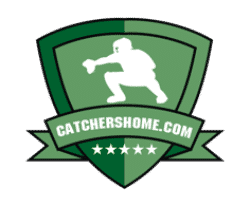Catchers and home plate go hand-in-hand. They do their work on and around the plate and depend on it to do their job successfully.
The following article goes into detail about this important base and symbol of the game and the position that we all love. In this article, we discuss home plate’s dimensions, its shape, its size, and even how it got its name.
Keep scrolling to learn more about home plate...
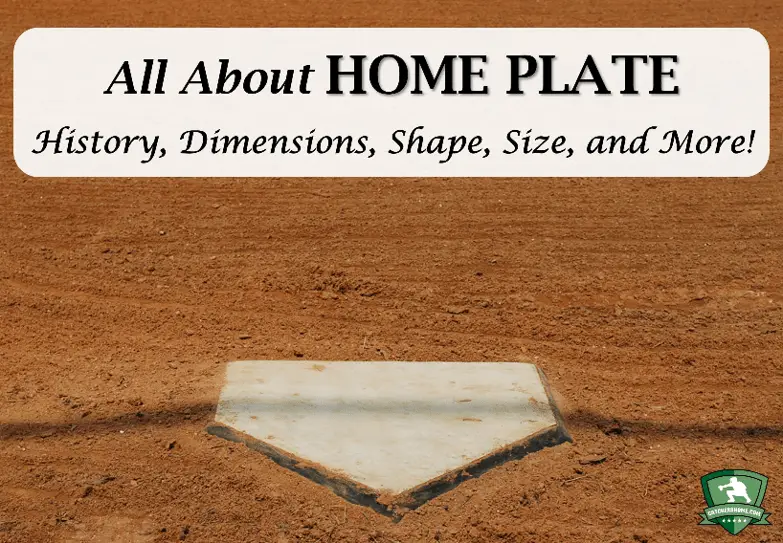
Home Plate Dimensions, Shape, Size and More
What is Home Plate?
Home plate is one of four bases in baseball and softball. It's positioned at the bottom of the diamond, between the batter's box.
Home plate is where the batter begins their offensive effort and it's where that effort ends.
For catchers, home plate is their north star. They line up behind it, get in their stance behind it, receive pitches behind it.
They protect it at all costs.
For pitchers, home plate is their target, their guideline, and their zone.
Home plate for umpires is a tool that helps them accurately call balls and strikes, and do so in a consistent manner.
In essence, home plate is many things to many people, depending on the role you play in the game at any one time.
It is an important symbol in baseball and softball, and it's especially important to catchers. So much so that we nearly made the logo for Catchers Home a home plate!
How Did Home Plate Get Its Name?
There are a few stories that point to how the name “home plate” took root.
The primary story is that home plate got its name because in the very early days of baseball (all the way back to 1857) a round dish was used for the base, which resembled a dinner “plate” from “home”.
The use of cookware helps explain why it ended up being called a plate and not home base!
Enjoy watching and listening to legendary Dodgers broadcaster, the late Vin Scully, as he briefly discussed this very topic.
Another theory about how home plate got its name is more symbolic. When the batter comes around to score, he or she finishes their play and is rewarded by symbolically returning back “home” to where they first started the play.
What Shape is Home Plate?
The shape of home plate is a pentagon.
Specifically, we call it an irregular pentagon because while it has five points and five sides like a pentagon, the sides are of unequal length.
Interestingly, home plate got its pentagonal shape a very long time ago. This shape was first introduced in time for the 1900 baseball season. Also a long time ago, the plate was made out of materials like wood, cast iron, or marble rather than its current composition of rubber.
Can you imagine sliding into a marble plate? Sounds painful to me.
There is great intentionality and purpose in the shape of the plate. For example, the two points closest to the pitcher are perfectly arranged so that a line can be drawn from near these points to first and third base, forming the baselines.
If the plate were a square like the other bases, the lines from the base’s corners would be branching into foul territory.
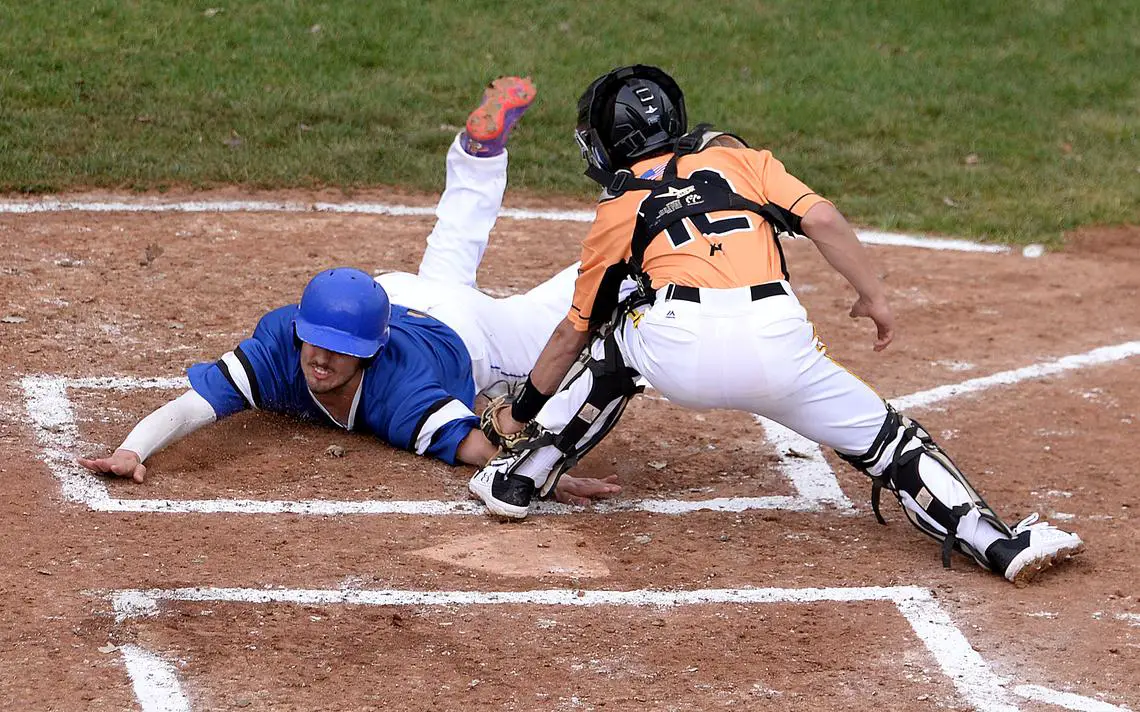
Why is Home Plate Shaped Differently From Other Bases?
Simply put, home plate is shaped differently than the other bases because its purpose is to help determine the strike zone, unlike the other bases!
This purpose and this shape benefits everyone: the pitcher, batter, catcher and umpire.
When the pentagonal shape of home plate was introduced prior to the 1900 season, it did not change the strike zone but better illuminated it. It gave pitchers a better target to aim for and it assisted umpires in making good, consistent calls.
This design has worked so well that the shape of home plate really hasn’t changed (with a few minor exceptions) since 1900.
Lastly, we wanted to acknowledge that yes - home plate does resemble the general shape of a house. Though it should be clear by now that home plate was not shaped that way on purpose.
Its resemblance to the shape of a house is just one of the cool side effects of home plate’s name, purpose and design!
What are the Dimensions of Home Plate?
A common question people have is "how big is home plate?"
The following should help answer that question, as you can find in the below text the specific dimensions of home plate for both baseball and softball.
Home Plate Size in Baseball
Home plate dimensions are 17 inches (43.18 cm) across the top, parallel to the pitcher’s rubber (also referred to as the “pitcher’s plate”).
It is 8.5 inches (21.59 cm) along the two sides, parallel to the batter’s box. And it is 12 inches (30.48 cm) along the two angled sides at the bottom of the plate, in alignment with the foul lines.
A baseball home plate should be flat and made out of white rubber, and the top two corners of the plate should be beveled, or sloped downward.
These standards come from section 2.02 of the MLB rulebook.
See the diagram below for a visual representation of the size of home plate.
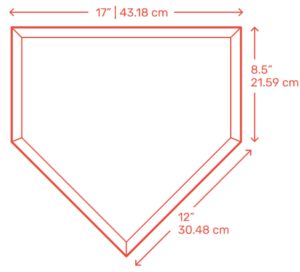
Home Plate Size in Softball
A softball home plate is the same size, shape and dimensions as a baseball home plate.
In short, they are the same.
MLB Home Plate Dimensions
The dimensions of home plate in the MLB are the same as stated above and are derived from section 2.02 of the MLB rulebook.
For reference, the rule book specifically states the following about the dimensions of home plate:
Home base shall be marked by a five-sided slab of whitened rubber. It shall be a 17-inch square with two of the corners removed so that one edge is 17 inches long, two adjacent sides are 8½ inches and the remaining two sides are 12 inches and set at an angle to make a point. It shall be set in the ground with the point at the intersection of the lines extending from home base to first base and to third base; with the 17-inch edge facing the pitcher’s plate, and the two 12-inch edges coinciding with the first and third base lines. The top edges of home base shall be beveled and the base shall be fixed in the ground level with the ground surface.
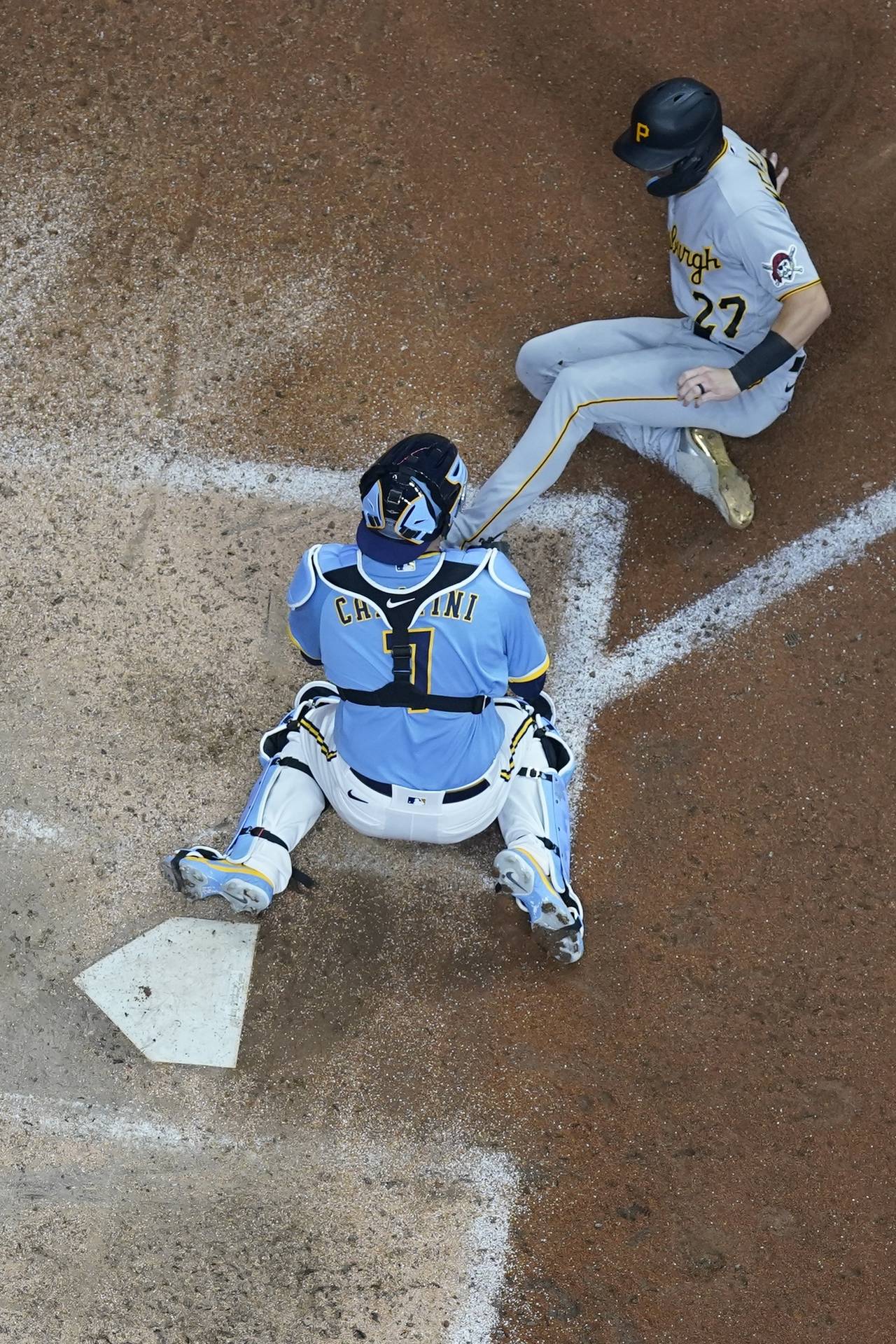
Other Frequently Asked Questions (FAQs)
Question: Is the size of home plate the same across every league, from youth leagues up to the pros?
Answer: The size of home plate is the same from the MLB on down through youth leagues.
As an example, the youth-aged Pony League calls in its rules and regulations document for the use of a "regulation sized home plate" in its games.
This phrase "regulation sized" refers to the standard size home plate that we discuss above, which measures 17 inches x 8.5 inches by 12 inches.
Question: How far is home plate to first base?
Answer: The distance between home and certain bases varies depending on the league you’re playing in. Generally speaking, home plate and bases are closer to one another in youth leagues and further from each other in adult leagues.
In Little League Baseball, for example, home plate and first base are 60 feet away from each other. In the MLB, the distance increases to 90 feet.
When measuring distances between home and any base, the measurement is based on the distance between the back tip of home plate and the base.
Question: How far is home plate to second base?
Answer: The distance between home plate and second base in Little League is 84 feet 10 ¼ inches, and in Major League Baseball it is 127 feet 3 and 3/8 inches away from each other. This is measured from the base to the back tip of home.
Question: How many sides does the home plate in baseball have?
Answer: Home plate has five sides.
Question: What shape is home plate?
Answer: The shape of home plate is a pentagon. It has five sides and five points.
Question: What is the apex of home plate?
Answer: You may have heard of the phrase "apex of home plate". What that is referring to is the point at the bottom of home plate where the two lower sides come together.
Question: How wide is home plate in MLB?
Answer: Home plate is 17 inches wide in the MLB.
Question: What way does home plate face?
Answer: The point (apex) of home plate points down, and the long, 17 inch flat edge represents the top boundary. It kind of looks like the outline of a house… if that house was flipped upside down!
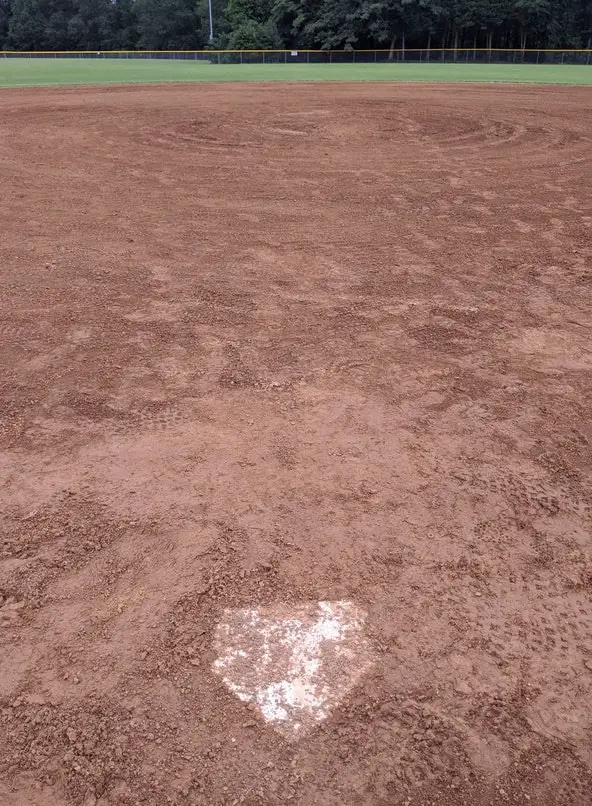
Thanks for Reading!
We hope that this article on home plate dimensions was helpful and that you learned something from it. If you are interested in reading other articles on similar topics, please click here.
If you have any follow up questions or comments, feel free to reach out to us!
You can go to our contact page or send an email to scott (at) catchershome (dot) com if you want to get in touch.
Thanks for stopping by Catchers Home!
Scott Perry
Scott Perry is the owner and lead author at Catchers Home. He's a former baseball player, a current coach, a husband and a Dad. He remains as passionate about baseball today as he was as a kid.
